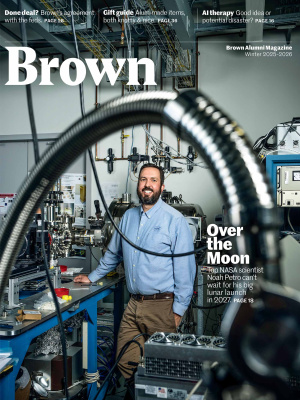Eat Your Bloody Vegetables
A recent group independent study project had students biting into the science and business of the booming alternative protein industry.
For decades, a vegan cheeseburger typically consisted of a lentil or bean disk and a slice of rubbery nondairy cheese that stubbornly refused to melt. Until recently, when it became a savory patty that bleeds just like beef—with a deliciously gooey faux fromage atop it.
More and more consumers are demanding vegan options for ethical, environmental, and health reasons, so the alternative protein industry has exploded in the last 15 years, with scientists fine-tuning ways to recreate the taste, texture, and appearance of animal proteins.
These trends were the launching point for last spring’s Group Independent Study Project (GISP) “The Future of Food: Understanding Alternative Proteins,” advised by Associate Professor of Engineering Daniel Harris. According to project leader Julia Figueiredo Krausz ’26, “the GISP explored innovation in protein production as a system for transformation at the intersection of science, policy, and culture.”
Participants not only learned the ingredients and chemistry behind all those new meat and dairy substitutes—they also explored why the market takes to some of them more than others.

To beef or not to beef?
The course began with an overview of alternative proteins, including the problems they could help solve. To provide the world with beef, chicken, eggs and more, farmers rely on concentrated feeding operations—some of the biggest contributors to pollution worldwide.
“There is so much land used for animal agriculture, both to raise animals directly and to grow all of the crops to feed animals,” says Luke Rossi ’26, another leader of the GISP. “Animals require a lot more resources—and create a lot more emissions.”
In fact, Jerry Lu ’25 says the environmental impact of eating meat was partly why he joined the GISP. “My mindset is that I will continue eating chicken, but in moderation,” he says. “This class just opened me to more possibilities.”
In the GISP, students compared traditional proteins to alternative products, looking at protein content, digestibility, allergens, affordability, and the amount of processing.
“People have a lot of concerns about alternative proteins being very highly processed,” Rossi says. “But something being highly processed doesn’t inherently make it unhealthy. A plant-based burger isn’t replacing a very clean animal-based product to begin with.”
But nutrition, climate, and health arguments aren’t enough to turn everyone from animal to plant foods, because, for many, the love of animal-based foods is deeply cultural.
“People grew up with campaigns such as ‘Got Milk?’ and learned that drinking milk will make their bones strong and that eating meat is necessary to grow,” Figueiredo Krausz says. Animal meat is at the heart of family traditions and cultural celebrations, she adds, like Grandma’s meatloaf or a Thanksgiving turkey.
“These social norms are hard, if not impossible, to dismantle,” she says—and that’s why vegan substitutes have focused heavily on recreating familiar flavors and textures.

Veggie burger revolution
The GISP spent weeks tackling the science, nutrition, and consumer acceptance behind plant-based, fermented, and cultivated proteins.
Plant-based proteins include foods made from soy, oats, lentils, and beans, processed to recreate the distribution of proteins, fats, minerals, and water present in animal tissue. While the market for plant-based proteins has grown, Lu noted during GISP discussions that American grocery stores still offer few plant-based options compared to stores in Taiwan, where he’s from. “They have tofu sheets, soybean curd that’s kind of like cutlets,” he said. “You’ve got stuff that replicates intestines. I guess that sounds gross, but it’s tofu.”
Fermentation has multiple categories, which students got tastes of for their spring break homework: Try an alt-protein! Shannon Feerick-Hillen ’26 tried a mycelium-based steak product called Meati that uses biomass fermentation, which produces protein by growing microorganisms that are then filtered out. This leaves behind a “brick of protein-rich mycelium, and then they season and flavor it,” she explains.
There’s also precision fermentation, where scientists genetically modify yeast or bacteria genes to produce heme, a compound that animals naturally contain in their blood. Add heme to a vegan product like an Impossible Burger and it recreates the taste of animal flesh.
In recent years, scientists have harnessed fermentation to create melty vegan cheeses, Figueiredo Krausz explained. Like traditional animal cheese, vegan cheese now uses live cultures to ferment vegetable milk. Newer technologies use precision fermentation to recreate milk proteins, creating a final product that is chemically identical to cheese without using animals.
Making alt-protein a thing
Rossi and Figueiredo Krausz invited researchers, entrepreneurs, and leaders in the industry to speak to the class weekly. They included Sorosh Tavakoli, CEO of Sweden’s Stockeld Dreamery, who spoke about the successful marketing of his vegan cheddar product. The speakers “added so much to the course, because suddenly you have an actual entrepreneur who is doing the stuff that you read about,” Figueiredo Krausz said.
A GISP can’t be taken twice, but Rossi and Figueiredo Krausz are still looking for ways to promote alt-protein education on campus. They head an on-campus club called the Brown Alternative Protein Project that is hoping to involve faculty and graduate students, both in research and coursework. Their end goal is to establish a recurring course on alternative proteins.





